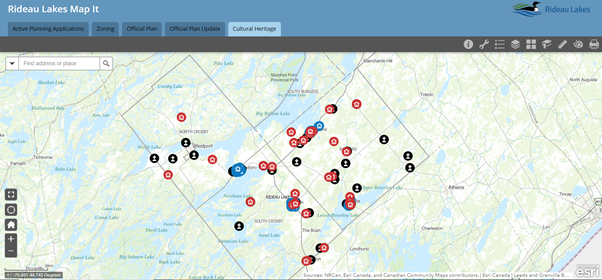See Ontario’s architectural gems shine on a drive to see designated heritage buildings that are the stars of their communities. Properties of heritage interest and their stories are detailed in the heritage walking tours and heritage driving tour brochures. Pour a hot cocoa and set out on an adventure of historical proportions! Here are just a handful of the historic buildings to discover in Rideau Lakes.
Lockmaster's House Museum
1724 Chaffey's Lock Rd, Chaffey's Lock
Built in 1844 as a low-cost substitute for a blockhouse to defend the canal against American-based raiders, the Chaffey's Lockmaster's house was originally a one-storey limestone building. A tin roof protected it in case of fire and two stone porches and gun-slits provided extra defence in case of attack. In 1894 it was renovated and a frame second-storey and kitchen addition were added. The house proved to be the social centre of Chaffeys – not only did it have the only phone in the village, but it also housed the local post office! It became a museum in 1982 in celebration of the 150th anniversary of the opening of the Rideau Canal. Watch the new documentary Fettercairn WWI on Indian Lake to learn more about Chaffeys Lock.
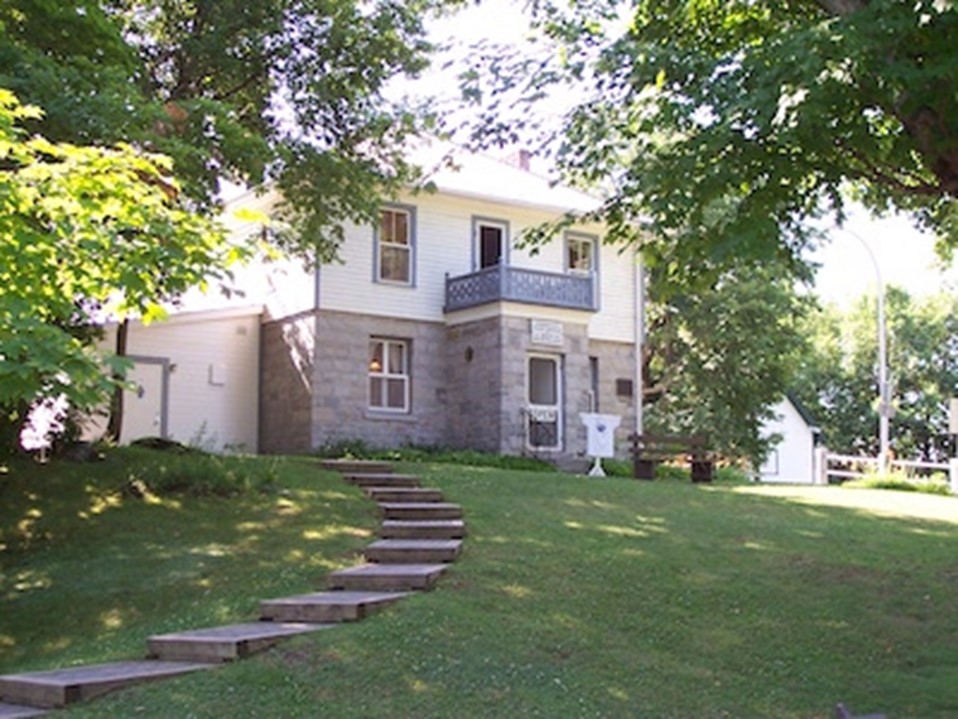 Photo: Lockmaster House Museum, 1724 Chaffeys Lock Road
Photo: Lockmaster House Museum, 1724 Chaffeys Lock Road
Old Stone Mill
44 King Street, Delta
Delta’s is the Old Stone Mill, built in 1810, now a seasonal museum and a designated National Historic Site of Canada. Drawing visitors from all over the world, this prized mill site provided the nucleus for a flourishing agricultural and industrial community throughout the 19th and early 20th century. Completely renovated, working millstones were installed for its 200th anniversary in 2010. It is open to the public from Victoria Day weekend to Labour Day and during events, where it continues to grind and sell locally-grown heritage Red Fife wheat, offer interpretation, exhibits and employs local students to conduct guided tours.
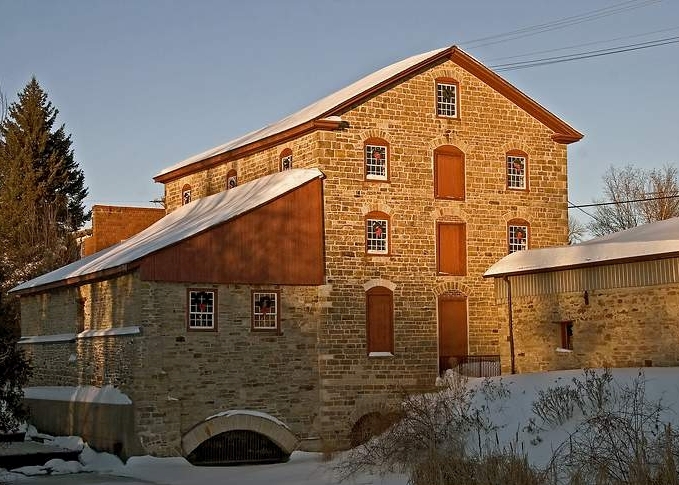
The Red Brick School
3 Halladay Street, Elgin
This architecturally elaborate two-room school opened in 1887. The Red Brick School, SS #5, is an excellent early example of the late 19th century campaign to improve Ontario’s system of public education through the construction of better buildings. It also illustrates that Elgin was a forward-looking community, erecting this building to showcase its local pride and commitment to progress through education. This L–shaped building is easily identified by its construction of red brick with yellow brick corner detailing, as well as the grand multi-paned windows (each with a dormer) and stone sills on the front façade. An interesting fact about the Red Brick School is that although it appears as if it is two storeys from the exterior, the two-room interior is only one storey with very high ceilings. Look for events here throughout the year through the Elgin and Area Heritage Society. Listen to the Story of the Elgin Quarries to learn more about the village.
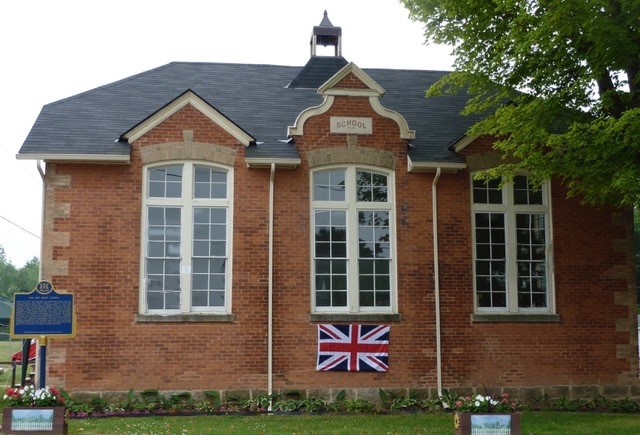 Photo: The Red Brick School in Elgin by Diane Haskins
Photo: The Red Brick School in Elgin by Diane Haskins
The Pimple
24 Pearl Street, Morton
Morton’s brick schoolhouse, built in 1853, was designed to incorporate the most current of educational philosophy and octagonal design. Used as a school until 1900, then as a residence, “The Pimple” survives as one of the most unique buildings in the Township. Large windows provided lots of natural light – this innovative design was rare at the time. Only one other octagonal school exists in Ontario! (*This architectural gem is on private property - please view from the road.) Listen to the Story of the Morton Pimple to learn more.
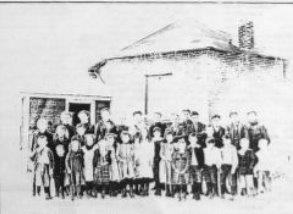 Photo: Morton School, "The Pimple"
Photo: Morton School, "The Pimple"
St. Mary’s Anglican Church
15 Brock Street, Newboro
St. Mary’s is celebrating a milestone in 2025; keep an eye out for news on its celebrations! The church was started by labourers building the Rideau Canal through Newboro, first meeting in the home of Benjamin Tett. Realizing the need for a permanent structure, Tett spearheaded the church’s construction by donating the land and helping to pay the workers' wages with credit from his store. It was built by the Stanton brothers and other congregation members, including John Poole Tett. This landmark features windows donated in memory of various community members (one of unique Tiffany artistry), helping to reinforce the collective memory of the community. This church is built in the Gothic Revival style and features pointed windows with lancets and a pointed transom above the entrance. The squared tower, which emphasizes verticality, has a belfry and short spire. The north façade has a gothic bay with arched stained glass windows. The interior demonstrates fine craftsmanship with a regency-gothic altar on a raised platform flanked by communion rails, butternut pews, a 'rostrum pulpit' and an organ and choir stalls. It has served the community as an Anglican Church from its construction to the present day. Watch The Rideau Canal The Big Breakthrough documentary to learn more about the history of Newboro.
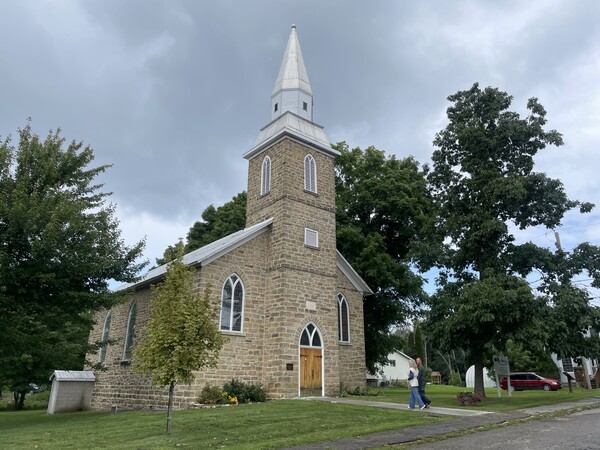 Photo: St Mary's in Newboro
Photo: St Mary's in Newboro
David Laidlaw House
328 Centreville Road, Westport*
The David Laidlaw House in North Crosby is a one and a half-storey stone house in the vernacular “Rideau Cottage” style which became the most popular form for a farm dwelling in Ontario between 1840 to 1875. Begun in 1849 and completed in 1852 by David Laidlaw II from locally quarried limestone, it still stands today as an important landmark in the area. Its exceptional heritage value is seen in heavy, well-cut corner quoins, stone lintels over most of the windows, side-lights and transom around the front door, arched window beneath gable roof-line with radiating stone voussoirs, two chimneys and the symmetrical façade. The 1842 census records ownership by David Laidlaw, who had emigrated from Scotland in 1839 to farm in Ontario. Following his death, his son, David Laidlaw II constructed the stone house that stands today. David Laidlaw III retained ownership of the house until his death in 1905. (*This architectural gem is on private property - please view from the road.)
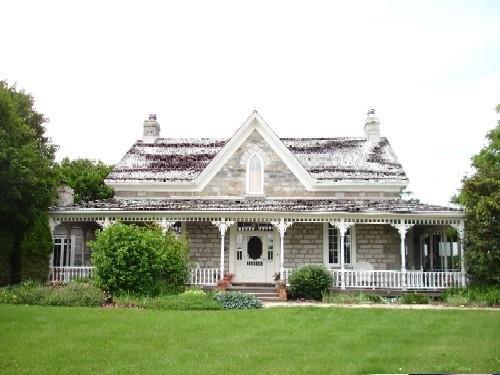 Photo: David Laidlaw House, 328 Centreville Road
Photo: David Laidlaw House, 328 Centreville Road
Emmanuel Heritage Centre
2767 Hwy 15, Portland
This Portland landmark is a charming example of a mid-nineteenth century rural church. The former Anglican Church is typical in size and style of early rural churches along the Rideau Canal (Gothic Revival), but uniquely built with local Nepean sandstone. It features a high gabled and metal covered roof, buttressed walls, plain wooden trim on eaves and verges, eight narrow, stained-glass pointed windows capped with voussoirs, the corners trimmed with stone quoins, a red steeple on the front façade, long vents on the steeple with semi-circular heads, and a double-leaved door located at the base of the steeple with pointed transom light. The church sits high on Portland Hill, overlooking the Village of Portland and Big Rideau Lake, on a half-acre donated by William Homer Sherwood and family, one of Portland’s first farmers. Construction was quickly completed in 1861 by local tradesmen William Willoughby (stonemason) and J. Horton and J. Earl (carpenters). In 1868 more land was obtained for a cemetery. Now, operated by the Portland on the Rideau Historical Society, it’s haven for community events, live music and much more.
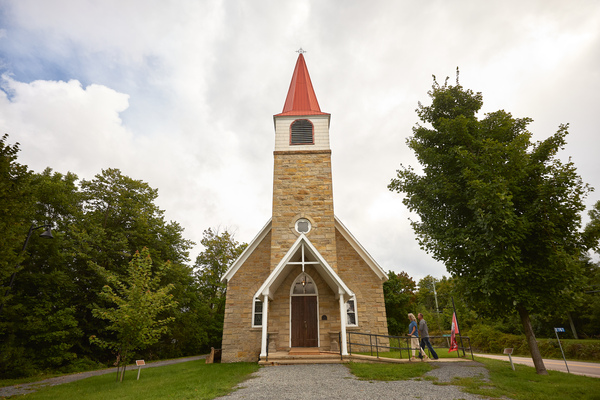 Photo: Emmanuel Heritage Centre by Matthew Liteplo
Photo: Emmanuel Heritage Centre by Matthew Liteplo
Wood Mausoleum & Cemetery
299 County Rd 29, Lombardy
The history of this impressive 19th-century stone vault and private cemetery is intriguing! The exterior of this mausoleum built in 1895 exhibits a beautifully mortared stone façade, and cast iron gates. This is the final resting place of Alexander Wood, co-founder of the Frost and Wood Company, which sold farm implements all across Canada and played a large role in the early success of Smith Falls. The Wood Mausoleum and Cemetery was constructed for Alexander Wood’s entombment, after the Wood family purchased the acre of land in South Elmsley for $100 on a farm facing the Maple Vale Cemetery. The last burial at the Wood Cemetery and Mausoleum took place in 1949, after which it was abandoned. The Township of Rideau Lakes recently assumed ownership of the cemetery and has started refurbishing it.
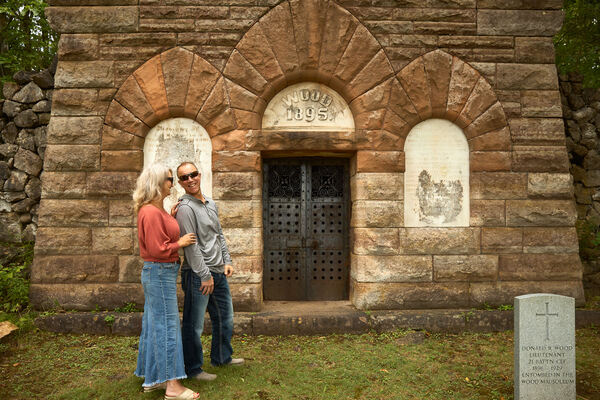 Photo: Wood Mausoleum by Matthew Liteplo
Photo: Wood Mausoleum by Matthew Liteplo
Blacksmith Road, Lombardy in South Elmsley
This historic road in the village of Lombardy is home to heritage buildings which were built in the 1800s as hotels, stores and residences. Many remain today, making the street an interesting walk. Let your imagination wander in the park on the street and stop for a sit overlooking Otter Creek. The street is a testament to years gone by when Lombardy was a thriving community with waterpower from the creek, a saw mill, shops, a cheese factory and blacksmith shop. See the former O’Reilly Hotel at 973 Blacksmith Road, built in the early 1800s, which also housed the village’s first post office and the South Elmsley Telephone Co. before containing the municipal offices and community hall. Down the road was the Klyne Hotel at 17 Blacksmith Road, built in 1876, originally called the Revere Hotel. This red brick home also served as a tavern in the First World War. Discover more and watch a documentary about taverns in Rideau Lakes! The Blacksmith Shop beside 34 Blacksmith Road was built around 1860 and first used as a cooper’s shop by George Houze, before being sold in 1933 to Donald Moodie. He became well known for operating it as such for many years, repairing sleighs and cutters, showing horses and settling wheels. Explore more in the South Elmsley and South Burgess Driving Tour!
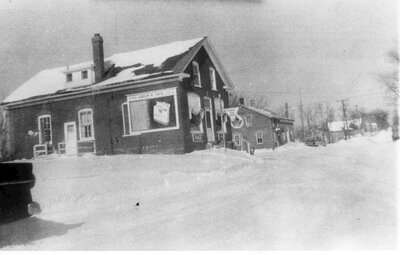 Photo: Gordon Smith's store in Lombardy c.1958. It was owned before by Michael Dooher, William McSpadden, Clarence Hogan and Percy Jones. On the far right was the cheese factory. The highway in 1958 passed right through the village.
Photo: Gordon Smith's store in Lombardy c.1958. It was owned before by Michael Dooher, William McSpadden, Clarence Hogan and Percy Jones. On the far right was the cheese factory. The highway in 1958 passed right through the village.
There is so much more to discover! The John Draffin House and Stone Manor Studios in Newboro, Elgin United Church, Hotel Kenney and the Stone Arch Dam in Jones Falls, Mother Barnes House in Plum Hollow, Wykes Boat Works in Harlem - the list of heritage buildings goes on. Uncover history in Rideau Lakes and marvel at the beauty of heritage buildings and the stories they tell of times past.


















